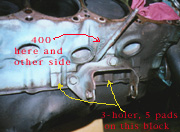Pontiac Block Identification
Today more and more Pontiac enthusiasts are considering engine swaps as an easy and economical way to improve power in their Pontiacs. Here's some information that may be helpful in your quest to identify that block you're thinking about.
Make sure it's a Pontiac block
All Pontiac blocks have a hydraulic lifter valley pan. The distributor hole is located on the rear deck of the block which allows for the easy intake removal without disturbing the distributor. (I've always liked that feature). While most Pontiac motors were painted blue, metallic blue or what I call "robin's egg" blue, color is only a telltale sign and not one that can be relied upon to determine the Pontiac line. You have to do more looking and verifying to be certain.
Freeze plugs provide more clues
Some Pontiac blocks have 2 large freeze plugs and some have 3 on each side of the block. Early blocks, those from inception through 1966 had 2. Pontiac engine blocks cast in 1967 through the last casting in 1978 have 3 freeze plugs on each side.


Motor mount holes
Ok, I didn't say this was easy, but check out the number of drilled motor mount holes on the block. Go ahead get down there and look. Pontiac blocks with only 2 bolts holes per side were cast before 1970. Based on my observations,1964 to1969 Pontiacs engines were all "2-holers." Blocks cast in 1970 to the last of the run (1978) had 5 holes per side, at least in theory.
Some blocks, like my 400 that's in my 79 TA 6.6, is different (see photo). It is a 3-holer with two blank pads (no holes). These pads can be drilled and tapped if necessary to accommodate a different engine mount. The other block is a "5-holer." These are all drilled and tapped. [Block belongs to enthusiast Will Baker.]Block displacement
Here's more help to find the engine displacement.
| 350/400/455 | Displacement numbers cast into block on driver's side near the front freeze plug. [You should also look on the opposite side too--check photo.] |
|
|
"428" located on driver's side near the center between the freeze plugs. |
|
|
No "421" numbers located anywhere; look for a square machined area on front passenger side deck where the block meets the head. |
|
|
No "389" numbers cast any where on the block; look for notch on passenger side deck where the block meets the head. |
Year of the block
What year is the block? At the rear of the engine at the top near the distributor hole can be found the important casting numbers that reveal the year of manufacture--the birth year. The fourth digit indicates the year of the casting. So, if you have examined the rest of the block, you can easily ascertain the year the block was manufactured. The other info in the string may be helpful, but is not usually to relevant. The first letter, could be A through L, signifies the month. A=Jan, B=Feb, and so on. After the letter are two digits; 01=1, 25=25. Remember the last digit is the year (0-9).
Where's the engine code
Sorry, but you really can't accurately determine the year of the engine by merely knowing the engine code. You have to put all the information together to be certain. Pontiac used two-letter engine codes in different years in various cars. In later years, Pontiac added a corresponding VIN number to the block. Whatever the case, you need to examine the front passenger side of the motor. If the VINs match, that determines the engine option from the factory. Look to see what's there. Based on my observations Pontiac engines started to include VINs on the block in 1972. [This paragraph was updated 2-25-00.]
Putting it all together
For example, you come across an engine that looks pretty clean. So you start to check it out. You look at the engine code and see it has the letters WF. So you take a peek under the distributor and see several casting numbers but the last one in the string is a 9. This could be a '59, '69, or '79. You need to keep going. Look at the freeze plugs next. You look and see three (3). The equation narrows it to a '69 block. You look further, scrape away the grease and low and behold you spot the casting numbers 428 between the two freeze plugs on the driver's side. A big smile erupts on your face, your respiration and heart beat pick up, you hear "Born to be Wild" in the background and your reach for your wallet... Hello--come back. Checking a Chiltons manual that covers 1969 tells you that the motor was rated at 370, and powered a 4 speed Grand Prix.